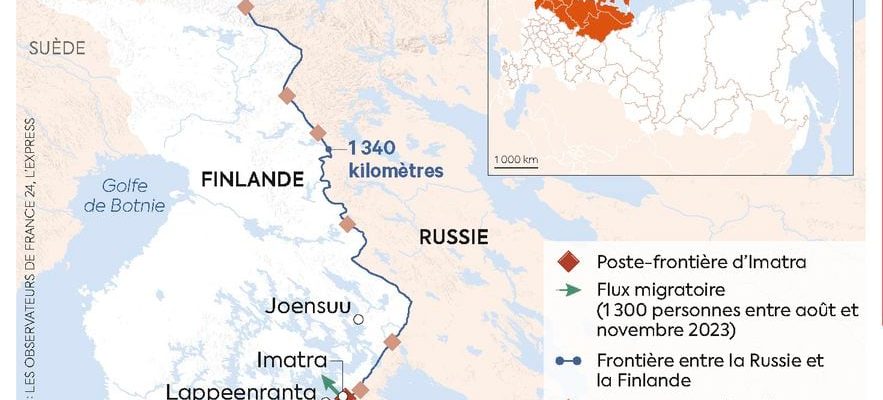The vast forest of pine, fir and birch stands silently near the Imatra border crossing in southeastern Finland. No signs of life in this area now closed to the public. Hidden from view, a steel barrier stands for approximately 3 kilometers. In 2026, it will stretch over 200 kilometers. That is a small portion of the 1,340 kilometers of border that Finland shares with Russia. His role ? “Control the flow of migrants,” explains Marko Saareks, deputy to the operational directorate of the border guards. Because Helsinki claims to be targeted by a “hybrid attack”, in the words of the Prime Minister, the conservative Petteri Orpo. Between August and November 2023, more than 1,300 people from Asia or Africa arrived in Finland via Russia, a route that has since been closed. The numbers remain low, but authorities say they are unusual for this region which is not a migration route. For Helsinki, the arrival of these migrants could well be one of Moscow’s responses to Finland’s entry into NATO almost a year ago.
But the threats are also military. In December, Vladimir Putin warned: “There was no problem [à la frontière finlandaise]but there will be some now, because we are going to create the Leningrad military district and concentrate a certain number of units there.” The Finns know that the Russian president’s statements are part of “propaganda logic for his people”, tries to put Marko Saareks into perspective.
It prevents. “We have always remained on our guard with our Russian neighbor and have never stopped developing our defense,” specifies Pekka Toveri, deputy within the national coalition (Kok, right). A former soldier, he is well aware of his country’s troubled relations with Russia. Declared independent in 1917, upon the fall of the Russian Empire, Finland was never part of the USSR. But the attack on Moscow in 1939, known as the “Winter War”, left its mark. “Especially since, throughout history, the Soviets have always sought to exert influence in Finland, whether through businesses, politicians or corruption,” he continues. Finnish intelligence services say in particular that they fear the presence of spies among asylum seekers.
© / cartography legends
The invasion of Ukraine changed everything
Today, says Pekka Toveri, the country is “ready in the event of an attack”. Finland has 12,000 soldiers and 870,000 reservists. “And now we have NATO,” he congratulates himself. Before the conflict in Ukraine, most Finns were opposed to membership, but the Russian invasion of 2022 changed everything. “We watched the war in Georgia [2008] then to Crimea [2014]. Little by little, we lost hope that Russia would become a democracy,” summarizes Mikkel Näkkäläjärvi, secretary of the Social Democratic Party, previously in power.
Finland is now the largest contact zone between Russia and NATO. And Alexander Stubb knows it well. Barely elected, the Finnish president announced that he wanted to change legislation to authorize the storage and transport of nuclear weapons on his soil. Earlier, in December, Helsinki reached an agreement to strengthen military cooperation with the United States. But while NATO is carrying out its largest maneuvers in the Far North since the end of the Cold War, some fear the long-term effects of the “glaciation” of relations with its Russian neighbor.
“Russia is an essential economic partner, recalls Jussi Laine, professor at the University of Eastern Finland. After the fall of the USSR, our relations were normalized, the eastern regions benefited from this.” Since the end of visas in September 2022, Russian tourists have deserted chic hotels. Before the invasion, they spent 1 million euros per day in the South Karelia region. Local companies, which worked a lot with Russia, must adapt. “Now, companies linked to the timber trade mainly export to China and Saudi Arabia,” says Mika Peltonen, president of the Karelian Chamber of Commerce, in Lappeenranta, a border town on Lake Saimaa in the south. -east of the country. The shift has only just begun.
.
